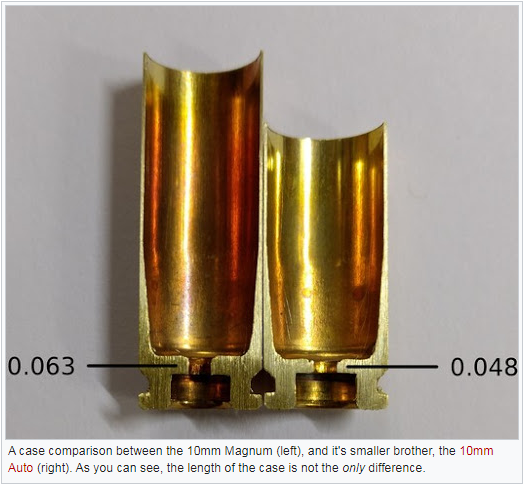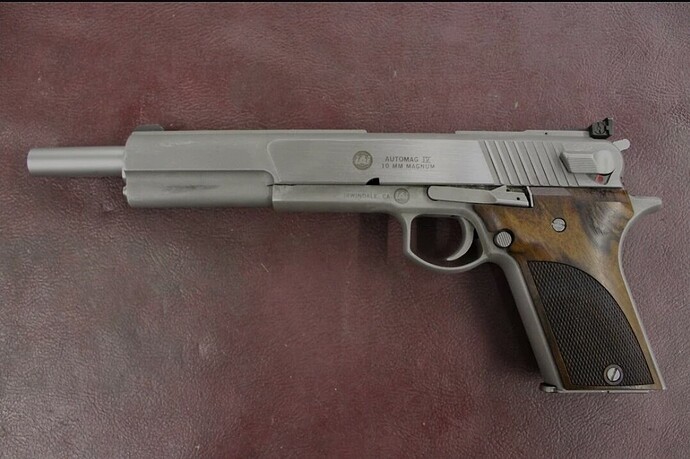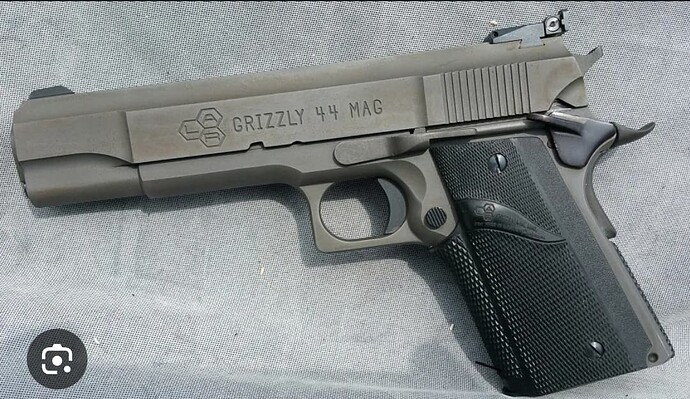Originally published at: https://sixguns.com/taffin-tests-the-10mm-magnum/
Never in the entire history of handgunning has the imagination of the shooting public been set afire as it was by the ten bore. No, not a long obsolete elephant gun for hunting Africa, but the latest ten bore, the 10MM family of handgun cartridges. First came the 10MM with Norma producing the ammunition utilizing 200 grain bullets at more than 1200 feet per second muzzle velocity. The first “production” gun was the Bren Ten, an improved CZ-75, as produced by the new company of Dornaus and Dixon. Problems surfaced quickly. Production was slower than had been expected, the ammunition was too powerful causing problems with the gun, and magazines were not even made in house but produced in Europe.
Dornaus and Dixon failed, with some buyers getting pistols but no magazines and the 10MM was dead. Well, not quite. Ammunition was available but the pistol was not. And then the unexpected happened. The very conservative firm of Colt came to the rescue taking an uncharacteristic major chance chambering the Government Model for the 10MM and saving the new cartridge. And in the process, they got everyone else’s attention and soon 10MM’s were on every manufacturer’s agenda.
After the infamous Miami/9MM Shootout, the FBI began taking a real serious look at the 10MM. But even though the ammunition was now downloaded from the original 200 grain bullet at over 1200 feet per second, it was still too much of a good thing. The FBI wanted it loaded so it could be handled quickly and accurately.
Bill Jordan, Elmer Keith, and Skeeter Skelton had asked for the ideal peace officer’s sixgun in the early 1960’s. The specifications were a 200 grain bullet at 950 feet per second. The FBI wanted a 180 grain bullet at 950 feet per second, a loading that is identical to the 1870’s .38-40. So why not a 9MM sized semi-automatic with a 10MM chambering? The result was the first new cartridge/gun combination from Smith and Wesson since the 1964 .41 Magnum which had been
preceded by the .357 Magnum in 1935 and the .44 Magnum in 1956. The downloaded 10MM became the .40 Smith & Wesson. The .40 S&W was/is a dead ringer for the FBI required 180 grain bullet at 950 feet per second.

The 10MM gathering was now two cartridges, the original 10MM with loadings available from 180’s at 950 feet per second to full house loads with bullet weights of 150 to 200 grains. The “defensive” 10MM was a reality with the .40 Smith & Wesson being touted as the perfect carry gun/cartridge combination. Was anything missing? By loading the 10MM to full house with 170 grain jacketed hollow points, the 10MM becomes a hunting pistol in many minds as it snapped at the heels of the .41 Magnum. Would it be possible to bring out a real ten bore hunting pistol? One that would equal and even exceed the .41 Magnum?
Enter the then-California based firm of AMT/IAI . All kinds of interesting things have been coming out of IAI, all semi-automatics and all stainless steel. The first practical semi-automatic for the .30 Carbine and the .22 Winchester Magnum Rimfire came to light. Then the .45 WinMag chambering. Now it was time to complete the ten bore trio and introduce a real hunting cartridge and the 10MM Magnum was born.
At the present time, the 10MM is strictly a wildcat cartridge much like the .375 and .445 SuperMags. Guns and brass have been available, but no loaded ammunition as this is strictly a roll-it-yourself proposition. A check of three rounds of fired brass from the loading room shows the .40 S&W to be .846″ in length, the 10MM goes .991″ and the full-sized 10MM Magnum is 1.242″. These are not official case lengths.
I have had perfectly good results loading 10MM Magnum brass using both Lyman and RCBS 10MM carbide dies. Such is not the case when trying to load 9MM Magnum brass with 9MM Parabellum dies. The carbide sizing die sizes both 10MM and 10MAG brass full length with no reloading problems surfacing. Use of 9MM carbide dies shrinks the 9MAG brass at the neck excessively.
The IAI AUTOMAG IV 10MM Magnum with eight and three-eighths inch barrel (measured from the rim of the case to the muzzle end) weighs a hefty fifty-four ounces. But even so ,after a day of pounding hundreds of full house rounds through the 10MAG, my wrist knew it had been in a fight. Actual felt recoil at the time of firing seems quite light for so much power, but the constant torque on the wrist results in some needed R and R for the firing hand.
Reloading the 10MAG is a straight forward proposition with no hidden pitfalls ready to ensnare the unsuspecting reloader. As mentioned, I used both RCBS and Lyman 10 MM Carbide die sets with excellent results. Throughout the testing, Federal #155 primers were used and nary a misfire reared its ugly head. The only malfunction throughout the testing was the once-in-awhile occurence of the Automag IV slide locking open.
The first bullets tried in the 10MAG were Hornady’s 200 grain full metal jacket bullets. This was a mistake. These bullets were intended for use in the standard 10MM and .40 S&W and gave only mediocre accuracy in the 10MAG. Since these full metal jacketed bullets have a full copper jacket extending over the nose, the base is unprotected lead. And therein lies the problem. I do not believe these bullets can stand up to the pressures of the 10MAG that result from bullets over 1500 feet per second. No fault of the bullet, but rather the application thereof.
Switching to Hornady’s XTP bullets, both 180 and 200 grain weights, gave completely different results. Both bullets have solid copper bases and hollow points and are naturals for the 10MM Magnum. All test-firing was done with five shot groups at 25 yards with velocities measured on an Oehler Model 35P. The best four shots out of five were measured for group size. This gives both me and my ammunition, not to mention the AutoMag IV, the benefit of the doubt. Favorite loads using the 180 XTP are 18.0 grains of AA #9 for 1505 feet per second and a group of four shots at one and three-eighths inches; 17.0 grains of #2400 for 1464 and one and three-eighths inches also; 21.0 grains of WW296 and 22.0 grains of H110 both shot into one and one-half inches with the former going 1625 feet per second and the latter 1662 feet per second.
Switching to the 200 XTP bullet, my particular favorite with the 10MAG, gave even better results than with the 180 XTP. One inch groups are the result of 16.0 grains of AA #9 at 1379 feet per second and 20.0 grains of H110 at 1507 feet per second. The old favorite sixgun powder, Hercules #2400, is not supposed to be a great performer in semi-automatics, but it borders on the fantastic in the 10 MM Magnum with 18.0 grains over Federal #155 primers driving the 200 grain Hornady XTP bullet to 1569 feet per second and making tight little one hole groups at 25 yards. These are experimental loads only until we know more about the 10 MM MAGNUM!!!
One of my favorite bullets for the 10MM and the .40 S&W, the Lyman #401043 was also tried in the 10MAG. This is a 180 grain flat-nosed bullet originally designed for the .38-40. Results were quite disappointing and paralleled the results I have had when trying to use some standard .45 Colt bullets in the .454 Casull. Cast bullets that do fine at 900 to 1200 feet per second, are often quite erratic when employed at 1500 plus feet per second. This was definitely the case with the use of the Lyman .38-40 bullet in the 10MAG as groups looked more like shotgun patterns. It will require a bullet specifically designed for the pressures and velocities of the 10MAG to get good results with cast bullets in the 10MM Magnum.
The 10 MM Magnum has definite applications as a hunting pistol and a long range silhouette pistol. Shooting informally at long ranges of 100 to 200 meters and using rocks as targets convinced me of this. Anything the .41 Magnum can do, the 10 Magnum can also do and perhaps do it even a little faster and a little better. That is a tough confession for an old sixgun man to make.
LOADS FOR THE 10MM MAGNUM
FIREARM: AMT/IAI
BARREL LENGTH: 8 3/8″
CHRONOGRAPH: OEHLER MODEL 35P
TEMPERATURE: 59 DEGREES
BRASS: *-* 10MM MAGNUM
PRIMER: FEDERAL 155
BULLET: HORNADY 180 XTP
LOAD
MV GROUP CASE EXPANSION*
15.0 GR. AA#9
1203 1 3/4″
.424″
16.0 GR. AA#9
1309 1
7/8"
.424"
17.0 GR. AA#9
1430 4 1/4″
.4245"
18.0 GR. AA#9
1505 1 3/8″
.4245"
21.0 GR. H110
1611 2″ ES=25
.4255″
21.0 GR. WW296
1625 1 1/2″ ES=11 .4255″
17.0 GR. #2400
1464 1 3/8″
.425″
18.0 GR. #2400
1550 2 3/4″ ES=23
.425″
14.0 GR. BLUE DOT
1539 2 1/2″
.425″
BULLET: HORNADY 200 FMJ
LOAD
MV CASE EXPANSION*
15.0 GR. AA#9
1256 .4245″
16.0 GR. AA#9
1338 .4245″
17.0 GR. AA#9
1431 .4245″
20.0 GR. H110
1499 .424″
21.0 GR. H110
1599 .425″
20.0 GR. WW296
1499 .424″
21.0 GR. WW296
1622 .425″
22.0 GR. WW296
1678 .425″
16.0 GR. #2400
1386 .424″
17.0 GR. #2400
1474 .4245″
18.0 GR. #2400
1522 .4245″
12.0 GR. BLUE DOT
1382 .425″
13.0 GR. BLUE DOT
1443 .425″
14.0 GR. BLUE DOT
1532 .425″
MEDIOCRE ACCURACY WITH 200 GRAIN FMJ BULLET IN 10MM MAGNUM.
BULLET: HORNADY 200 XTP
LOAD
MV GROUP CASE EXPANSION*
16.0 GR. AA#9
1379 1″
.425″
17.0 GR. AA#9
1452 2″ ES=20 .425″
18.0 GR. AA#9
1477 2 5/8″ .4255″
20.0 GR. H110
1507 1″ .4245″
21.0 GR. H110
1597 3 1/4″ ES=26 .425″
20.0 GR. WW296
1561 3″
.425″
21.0 GR. WW296
1621 2″
.426″
16.0 GR. #2400
1421 3 1/8″ .425″
17.0 GR. #2400
1503 2 1/4″ ES=25 .4255″
18.0 GR. #2400
1569 5/8″
.4255″
12.0 GR. BLUE DOT
1391 2 1/4″ .425″
13.0 GR. BLUE DOT
1461 2 1/8″ ES=28 .4255″
14.0 GR. BLUE DOT
1529 3″
.426″
DIAMETER OF UNFIRED BRASS ABOVE WEB IS .421″

